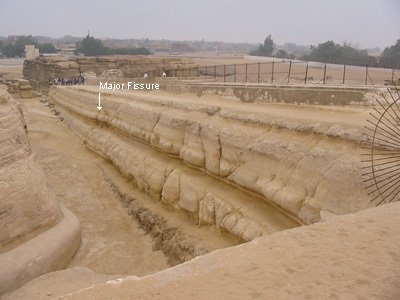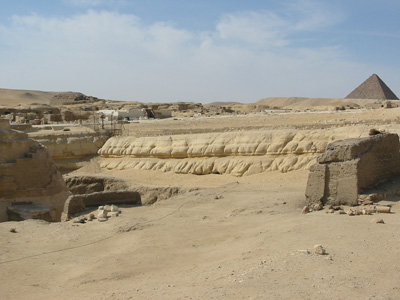
Fig. 9.1. The southern wall of the Sphinx enclosure. Larger resolution image here (492 KB). Courtesy and copyright of Colin Reader.
The distribution of jointing along the western enclosure wall appears to be uniform and the wall shows consistent erosion along its length. We do not have a less eroded portion with which to determine how far from the vertical the original wall was cut, but it seems to have eroded back more severely than the southern wall. The western half of the southern wall, and the entire length of the western wall, appear to have eroded under some influence coming from the west that diminished as it moved east and that did not affect the Sphinx, which was surrounded by open space. Runoff is the most plausible influence.
It is doubtful that runoff entered the enclosure in any significant amount after the quarrying west of the Sphinx. The quarries do not seem to have been refilled up to the elevation of the Sphinx enclosure walls before the area sanded over at the end of the third millennium. The process that filled the quarries with sand would have filled the abandoned Sphinx enclosure as well, and even if it didn't, it is doubtful that the permeable sand could have supported runoff. Subsurface water flow or interflow, if it occurred, should have spared nearly all of the southern wall and not left markings that still survive on later tombs cut into the western wall. Unless a closer examination of the jointing along the southern and western walls provides evidence for regarding the distribution of joints as the reason for the pattern of erosion, surface runoff from some time before Khufu seems the most parsimonious explanation for the condition of the western walls.
The northern terrace wall. The northern terrace wall has two distinct sections that have been debated as part of the controversy: a weathered section opposite the north flank of the Sphinx and an almost unweathered section opposite the north side of the Sphinx Temple. If the latter was an Old Kingdom cutting, the section across from the Sphinx would seem to be evidence of an older excavation.
The contrast between the two sections is not, however, as clear as the overall appearance of the two walls would suggest. The terrace shelf directly behind (west of) the Sphinx has a vertical drop from its ledge to the floor. As the wall moves north and then east opposite the north flank of the Sphinx, the ledge then abruptly recedes, leaving a depressed upward-sloping formation of paw-like humps east of the major fissure. Erosion alone is unlikely to have produced a shape in Member I rock so much flatter than the Member II rock of the western wall above it. It is more likely that the terrace wall opposite the north flank of the Sphinx was cut back and incised into humps by the original workmen for later removal.[1] The wall began its weathering with a flattened shape that was the result of excavation. How much the condition of the wall today can be attributed to erosion and how much to the original excavation is unclear, but the flattened shape is clearly man-made.
However, the northern terrace wall opposite the Sphinx still preserves a vertical rise a few meters above the floor (Fig. 9.2 below, indicated by black arrows). This low-rise wall may be compared to the vertical face of the terrace wall opposite the Sphinx Temple (Fig. 9.3 below). Although indentations in the former could have been part of the excavation, the gulleying in the rock more strongly suggests erosion. The low-rise wall opposite the Sphinx appears to be more eroded than the vertical wall opposite the Sphinx Temple, and also appears to be more eroded than the exposed portion of the wall as it continues just outside (east) of the temple (Fig. 9.3 below, see also Fig. 8.5). The vertical wall opposite the Sphinx Temple may have enjoyed some protection from the narrowness of the passageway. But it should be noted that the hardness of the Member I rock would have made the stone both here and inside the enclosure less susceptible to erosion. A noticeable difference between the low-rise wall opposite the Sphinx and the wall opposite the Sphinx Temple would suggest a difference in date of exposure.
Sedimentology and hydrology of the site. During the fourth and early part of the third millennia, Giza had a sandy soil with a thin mat of vegetation. This surface saturated quickly during rainstorms and produced runoff that flowed downhill toward the Nile River. Runoff would have also transported some of the topsoil as sediments. Over time, these sediments would have built up in a place as small and confined as the Sphinx enclosure. Once the site had filled, the walls on four sides would have retained the soil and caused any vegetation on the surrounding plateau to extend over the site.
Reader's more conservative dating is only a few centuries earlier than the conventional date, and it is possible that the walls of the Sphinx enclosure could have remained above any sediment buildup during this time. Runoff was more violent in the late prehistoric period. A prehistoric Sphinx enclosure might have weathered more quickly as a result but sediment buildup might have been faster. A prehistoric Sphinx may not have been open to runoff any longer than an Early Dynastic one.
It is clear, however, that the enclosure was open at least long enough for some erosion by runoff to occur on the floor. The major fissure on the southern wall served as a water spout, incising a drainage channel on the floor below. The channel may not have required much water to be incised because it follows Member II rock. But its position flowing from the major fissure makes it likely that it was a water channel, and as such it is evidence that runoff entered the enclosure. The absence of any Egyptian effort to block the fissure suggests that the channel formed during a period of neglect, and to be incised into the floor, the channel needed to be free of sand and sediment for some time. There is also evidence of water damage to the floor on the north side of the Sphinx that is not evident on the south side.[2] It is not clear how ancient this damage was but it points to the collection of water on the floor and its movement downslope with sufficient force to erode the Member I rock on the northern side.
Campbell's Tomb. The nearby shaft of Campbell's Tomb was cleared of sand in 1830 and has been cited as evidence of a younger stage of the erosion visible in the Sphinx enclosure. The twentieth century dating of similar tombs to the Late Dynastic period appears to have superseded the view of nineteenth century scholars that the tomb was of Fourth Dynasty origin.[3] If the shaft was in fact an Old Kingdom one, or was reused in the Late period, its condition could have a bearing on the age of the Sphinx. But unless a new case can be made for backdating it, the tomb must be considered a Late period remain.
The straight-line fissuring and lack of incipient coving on the walls of Campbell's Tomb raise a valid question about whether the erosion of its walls can be compared to the erosion in the Sphinx enclosure. But what caused the erosion in Campbell's Tomb is still a legitimate question. If the shaft of the tomb weathered equally on all four walls, weathering under sand would be more likely the reason than subsurface interflow from the north and west.
Subsurface weathering. Reader and Harrell pointed to the closeness of Schoch's sounding depths to the natural west-east dip of the plateau and argued that his soundings had detected only a natural bedding difference in the rock. Schoch responded by pointing to the north-south dip of the plateau and to the fact that his two flank lines, S1 and S2, were of nearly the same depth. However, Schoch has not specified a dip angle at the Sphinx nor the distance between the two lines, and there is considerable imprecision among scholars about exactly what the dip angle is, with estimates ranging from 2.5 to as high as 10 degrees.
The lateral distance between Schoch's S1 and S2 lines appears to be about thirty meters. If the dip angle of the plateau at the Sphinx is very low, Schoch's soundings may only reflect the natural dip, but if the dip angle is higher, his results are less likely to be the result of natural bedding. It is not clear whether the S3 and S4 lines should be relevant to the dip of the rock. Schoch's S4 line in front of the Sphinx shows a relatively steep dip from north to south, while his S3 line in back shows very little dip.
Drill samples are needed to determine whether the subsurface rock has the characteristics that would confirm that it is in fact weathered rock. Apparently there was drilling in the 1970s and 1990s to explore suspected voids under and around the Sphinx. Most unfortunately, these drillings do not seem to have preserved any subsurface rock samples for chemical analysis, a purpose that could have been justified on conservation grounds. Recent plans for conservation include the study of subsurface rock and it is to be hoped that any new samples taken will be preserved and made available for analysis of any weathering characteristics. 1. If this is correct, then the unprotected cutback inside the enclosure that Reader identified with the Old Kingdom may have been the first of the hump-like sections to be removed.
2. See the paper by Gian Luigi Nicola, "Some Considerations for the Preservation of the Sphinx," in Feisal A. Esmael, ed., Book of Proceedings of the First International Symposium on the Great Sphinx (Cairo, 1992), pp. 251-263 (especially pp. 259-261).
3. For the earlier view, see W. M. Flinders Petrie, The Pyramids and Temples of Gizeh (London, Field and Tuer, 1883), Chapter 15, Section 104. For the current view, see Kathryn A. Bard (ed) Encyclopedia of the Archaeology of Ancient Egypt (London and New York: Routledge, 1999), pp. 432-438.

Fig. 9.1. The western wall of the Sphinx enclosure, showing erosion consistently along its length. Larger resolution image here (508 KB). Courtesy and copyright of Colin Reader.

Fig. 9.2. The low-rise vertical face of the northern terrace wall opposite the Sphinx (marked by black arrows). Larger resolution image here (448 KB). Courtesy and copyright of Colin Reader.

Fig. 9.3. The vertical face of the northern terrace wall (left) opposite the north wall of the Sphinx Temple (right). Larger resolution image here (320 KB). Courtesy and copyright of Colin Reader.
Notes
Go to next page.
Go to last page.
Go to index page.